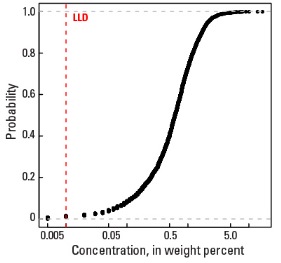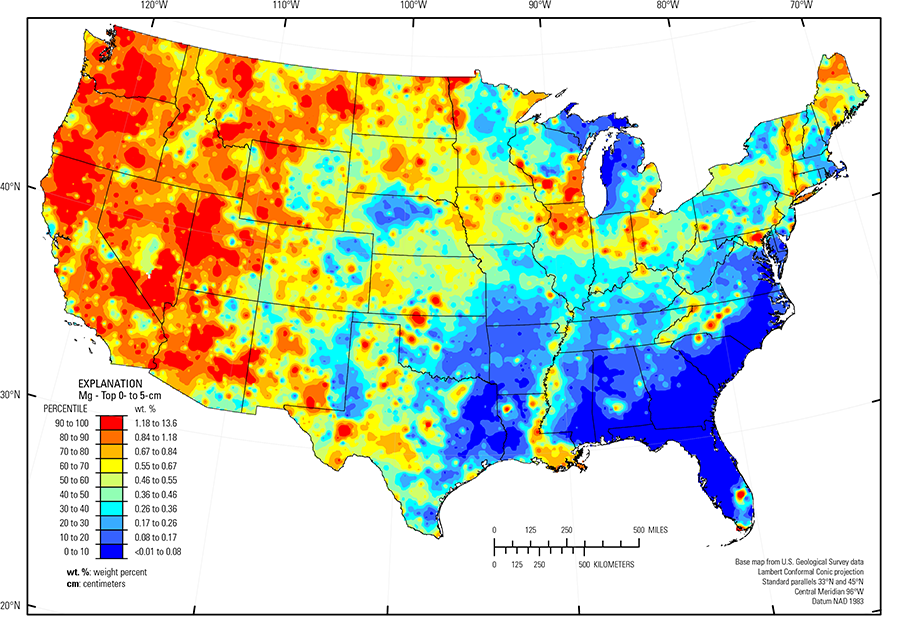
The purpose of these interpretive discussions is to provide a perspective on regional- and national-scale variations in element and mineral distributions in soils and their likely causes. The significant spatial variations shown by most elements and minerals can commonly be attributed to geologic sources in underlying parent materials, but other spatial variations seem clearly related to additional factors such as climate, the age of soils, transported source material, and anthropogenic influences. We attempt to distinguish the influence of these various factors on a regional and national scale. Numerous more local features might similarly be related to these same factors, but these features also have some probability of being an artifact of a random sampling of variable compositions, so that there is some probability of samples with similar compositions occurring in clusters of two or more adjacent sites by chance. Distinguishing such random occurrences from true variability is beyond the scope of the data from which these maps are constructed. Some caution, therefore, is advisable in interpreting the significance of these more local features unless some unique sources or processes can clearly be related to them.
Magnesium (Mg) is a metallic element used extensively in the manufacture of products that benefit from being lightweight such as car seats, luggage, laptops, cameras, and power tools. Magnesium–aluminum (Al) alloys are used in airplanes and missiles because of their strength and light weight. The metal burns with a brilliant white light and is used in flares, photographic flashbulbs, and pyrotechnics. Magnesium is essential for all life. Chlorophyll is a Mg compound that allows photosynthesis to take place. The element is essential for all organisms and is generally nontoxic. Magnesium deficiency may promote hypertension, cardiovascular disease, type–2 diabetes, and osteoporosis in humans.
Magnesium is a common element in most rocks and soils. The abundance of Mg in the Earth's upper continental crust is estimated to be about 1.5 weight percent (wt. %)(Rudnick and Gao, 2003). Magnesium occurs in a number of ferromagnesian silicate minerals, such as olivine, pyroxene, hornblende, biotite, serpentine group minerals, and talc. These minerals are characteristic of ultramafic and mafic igneous and metamorphic rocks. Ultramafic rocks typically contain, on average, about 20.8 wt. % Mg, whereas mafic rocks contain, on average, only about 4.6 wt. % Mg. Magnesium in sedimentary rocks most commonly occurs as dolomite (CaMg(CO3)2) in dolostone, or as iron (Fe)–Mg–rich clays in shale. Dolomite contains about 13 wt. % Mg, whereas shale contains only about 1.6 wt. % Mg. Limestone averages about 0.4 wt. % Mg and sandstone about 0.7 wt. %.
Magnesium–bearing minerals also occur in alluvial, eolian, or glacial deposits derived from bedrock containing either primary or secondary Mg silicate or Mg carbonate minerals. In soils, ferromagnesian silicate minerals are highly susceptible to weathering, typically forming sheet silicates, such as chlorite, smectite, and vermiculite, which have a common basal spacing of 14 Å (1Å = 10–10 meters). Dolomite in soils also quickly weathers in warm, humid climates, releasing both calcium (Ca) and Mg. Magnesium is a macronutrient for plants and can be absorbed from soil solution. Magnesium deficiencies in soils can be alleviated by applying Mg fertilizers. Thus, the distribution of Mg in soils is controlled by a diverse set of factors, including the mineralogy of the soil parent materials, climate controls on weathering, biological activity, and agricultural practices.
Statistics and information on the worldwide supply of, demand for, and flow of Mg–bearing materials are available through the U.S. Geological Survey (USGS) National Minerals Information Center (NMIC website).
In our data, the median Mg concentration is 0.61 wt. % in the soil C horizon, and 0.46 wt. % in both the soil A horizon and the top 0- to 5-cm layer (see the summary statistics [open in new window]). The map patterns for Mg in the soil A horizon and top 0- to 5-cm layer are similar to each other, but somewhat distinct from the Mg pattern in the soil C horizon, especially in areas where dolomite is a source of Mg in soil. Map patterns for topsoils (soil A horizon and top 0- to 5-cm layer) show a higher correlation with the soil C horizon in areas underlain by ultramafic bedrock.
Soils with the highest Mg concentrations in the soil C horizon are located in the southern Siskiyou–Trinity Area (USDA, 2006) in northern California. Bedrock in this area includes large areas of metamorphosed ultramafic rock mantled by 'serpentine' soils. These ultramafic–derived soils have unusual, but specific mineralogy (typically serpentine group minerals and talc) and chemistry (high Mg and chromium (Cr) and low calcium (Ca) and potassium (K)), and support an unusual set of plant species tolerant of these extreme soil conditions. Serpentine soils in central Maryland also have high Mg concentrations. Soils developed from mafic rocks or materials derived from mafic rocks are present in much of the Pacific Northwest and in parts of Arizona, Utah, and Wyoming.
Many soils have high Mg concentrations because of the occurrence of dolomite in the soil parent materials. In the northern part of the Mojave Desert (USDA, 2006) in southern Nevada, soils with high Mg concentrations (often with measurable quantities of dolomite in our data) formed on marine limestone and dolostone or on alluvial or eolian deposits derived from those rocks. In restricted basins in arid and semiarid environments of the southwest, high Mg concentrations in soils are related to dolomite precipitates in evaporite deposits, for example within the Great Salt Lake Area (USDA, 2006).
The distribution of Mg in soils of the Upper Midwest is related to glacial provenance, and most commonly to the distribution of dolomite in glacial materials. In the Upper Midwest, melting of glacial ice following late Wisconsinan period advances (16,000 to 12,000 years ago) left the region north of the southern glacial limit (Soller and others, 2012) mantled with a blanket of mixed, immature sediments, from which present–day soils developed. Individual ice lobes (Grimley, 2000) created distinct patterns in soil mineralogy and geochemistry because of varying provenance and ice transport paths. 'Gray' (carbonate– and shale–rich) tills in the James and Des Moines lobes (Grimley, 2000) were derived from Cretaceous sedimentary rocks (dolostone, limestone, and shale). In the same region, glacial lake clays of Glacial Lake Agassiz (Grimley, 2000) along the North Dakota–Minnesota border also contain Mg derived from dolomite. Gray tills were transported significant distances to the south and southeast from their source and deposited in areas underlain by Precambrian bedrock. 'Red' quartz– and feldspar–rich till deposited in central Minnesota, northern Wisconsin, and northwestern Michigan have a Precambrian crystalline rock/red sandstone provenance with no material derived from Mg–bearing carbonate bedrock. Till in northeastern Minnesota has a local Precambrian basalt and gabbro provenance (Duluth Complex), and Mg in soils is derived from ferromagnesian minerals rather than dolomite. Soils with high Mg concentrations in eastern Wisconsin, northern Illinois, eastern Indiana, western Ohio and eastern Michigan developed on till and other glacial deposits sourced from carbonate bedrock.
Magnesium concentrations north of the southern glacial limit (Soller and others, 2012) are higher in the soil C horizon than in topsoil (soil A horizon and top 0- to 5-cm layer). In this climate setting, dolomite and other carbonate minerals are susceptible to weathering, so Mg is typically depleted in topsoil compared to deeper soil. However, dolomite is often spread across agricultural fields to alleviate Mg deficiency. Many sites in the Upper Midwest that have high Mg concentrations and dolomite in the soil A horizon but low Mg concentrations and no dolomite in the soil C horizon may reflect addition of Mg fertilizers to acidic sandy soils.
In many parts of the West, there is less of a contrast in Mg concentrations between topsoil and deeper soils. This continuity may reflect the presence of ferromagnesian minerals in soils across areas of mafic and ultramafic rocks in areas such as the Pacific Northwest and northern California. In arid and semiarid parts of the West, low precipitation means that Mg is not leached from soil, but may form secondary Mg minerals such that topsoils can have higher Mg concentrations than deeper soils.
Despite the presence of underlying crystalline and carbonate bedrock with original Mg silicate or carbonate minerals in the Piedmont (Fenneman and Johnson, 1946), intense, long–term weathering has destroyed much of the original mineralogy, and leached Mg from the soil profile.
In other areas, Mg minerals were never present in the soil parent materials. Examples include:
- Nebraska Sand Hills (USDA, 2006) (soil dominated by quartz and plagioclase feldspar in an area of unconsolidated sand dunes and sand sheets);
- Parts of the Southern High Plains (USDA, 2006) of eastern New Mexico and northwestern Texas (quartz–rich eolian sands and alluvial sediments); and
- Gulf and Atlantic Coastal Plain (Fenneman and Johnson, 1946) (quartz–rich sedimentary rocks and unconsolidated sediments).
The Gulf and Atlantic Coastal Plain is bisected by the Southern Mississippi River Alluvium and the Southern Mississippi Valley Loess (USDA, 2006). Alluvial sediments have deposited in the Mississippi River valley as the river flooded in recent geologic time. When these sediments dried, winds picked up the fine material and deposited it in thick loess sheets, mainly along the east side of the river valley. The youngest loess sheets are about 10,000 years old. A pattern of higher Mg in soils developed on these young sediments reflects long–range transport of Mg–bearing materials (likely clays) from the upper part of the Mississippi River drainage basin.
Statistics - 0 TO 5 CM
| Number of samples | 4,841 |
| LLD | 0.01 wt. % |
| Number below LLD | 50 |
| Minimum | <0.01 wt. % |
| 5 percentile | 0.03 wt. % |
| 25 percentile | 0.22 wt. % |
| 50 percentile | 0.46 wt. % |
| 75 percentile | 0.74 wt. % |
| 95 percentile | 1.58 wt. % |
| Maximum | 13.6 wt. % |
| MAD | 0.385 wt. % |
| Robust CV | 83.8% |
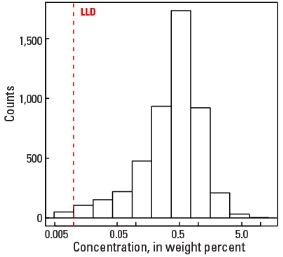
Histogram
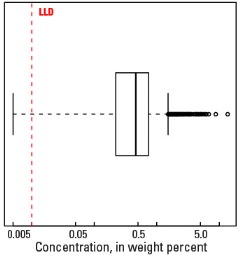
Boxplot
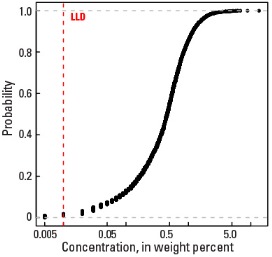
Empirical cumulative distribution function
Statistics - A Horizon
| Number of samples | 4,813 |
| LLD | 0.01 wt. % |
| Number below LLD | 41 |
| Minimum | <0.01 wt. % |
| 5 percentile | 0.04 wt. % |
| 25 percentile | 0.21 wt. % |
| 50 percentile | 0.46 wt. % |
| 75 percentile | 0.75 wt. % |
| 95 percentile | 1.55 wt. % |
| Maximum | 13.3 wt. % |
| MAD | 0.385 wt. % |
| Robust CV | 83.8 % |
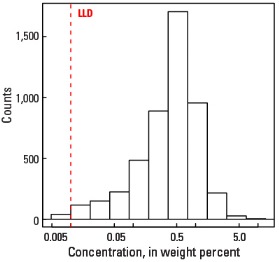
Histogram
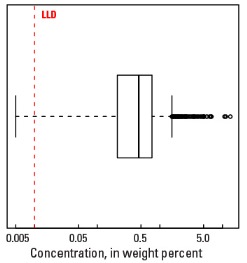
Boxplot
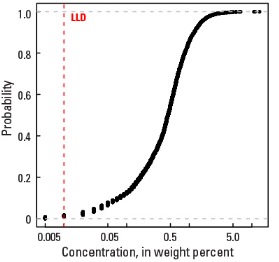
Empirical cumulative distribution function
Statistics - C Horizon
| Number of samples | 4,780 |
| LLD | 0.01 wt. % |
| Number below LLD | 41 |
| Minimum | <0.01 wt. % |
| 5 percentile | 0.06 wt. % |
| 25 percentile | 0.32 wt. % |
| 50 percentile | 0.61 wt. % |
| 75 percentile | 1.06 wt. % |
| 95 percentile | 2.14 wt. % |
| Maximum | 16.80 wt. % |
| MAD | 0.519 wt. % |
| Robust CV | 85.1 % |
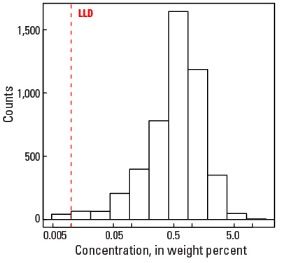
Histogram
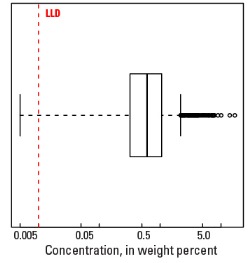
Boxplot
